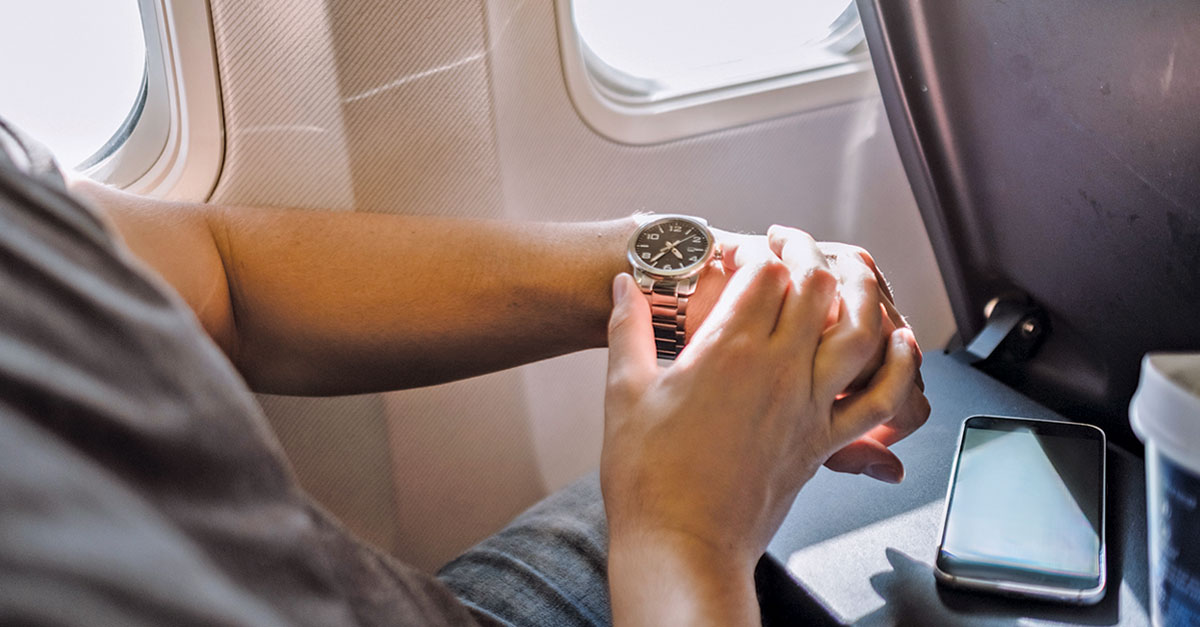It’s fun to see distant, exotic places, but if you’re zoned out from jet lag, it’s not nearly as much fun as it could be. Yes, eventually you adjust. But why lose precious vacation days (or productive workdays)? You don’t have to.
Here are three top experts’ favorite techniques to quickly sync your body clock to a new local time. Bonus: You can use these strategies again when you get back home…
TRY MELATONIN—THE RIGHT WAY
On average, our bodies tend to naturally adjust to time zones at a rate of one or two per day—so recovering from flying from Miami to Paris, six time zones away, can take up to five days. To shorten the recovery time, sleep specialist Michael J. Breus, PhD, recommends melatonin…taken in the right dose.
How it works: Melatonin is a sleep-enhancing hormone produced in the brain in step with Earth’s 24-hour cycle of daylight and darkness. Levels are naturally highest at night (even if your body doesn’t think it’s night) and lowest upon exposure to sunlight in the morning (ditto). When you travel long distances, your body’s rhythm gets confused by the external light and dark signals of your new location. The effect is especially pronounced when you travel more than three time zones eastward.
Try this: Melatonin is widely available as an over-the-counter supplement. To reduce jet lag, take 0.5 mg on the plane 90 minutes before bedtime in the place you’re traveling to. A similar protocol was found to be remarkably effective in reducing jet lag for airline passengers, airline staff and military personnel who crossed five or more time zones in a UK study that compared oral melatonin with a placebo or medication.
Important: Although melatonin is sold in much higher doses than the 0.5 mg mentioned here, the smaller amount is just as effective—and less likely to cause side effects such as headache, dizziness or stomach irritation. (You might have to buy a 1-mg form and split it in half, which is fine.) Because melatonin can have side effects, such as those described above, and can interact with other medications, such as anti-depressants and blood pressure drugs, check with your health-care provider before taking melatonin.
CHERRY REMEDY
Would you rather eat a natural source of melatonin to reset your body clock? If so, tart cherries are one of the few foods known to contain the hormone and can be an effective remedy that is also tasty (albeit tart). Juice made from tart cherries also works. A study reported in Journal of Nutrition, Health & Aging found that, compared with a placebo drink, drinking tart cherry juice was better at increasing total nighttime sleep and reducing the number of awakenings.
Superfoods expert Wendy Bazilian, DrPH, RD, has found that staying hydrated, avoiding alcohol right before and during travel and getting regular daily exercise during your trip combined with the following protocol works against jet lag…
• During the two days prior to departure, drink six ounces of 100% tart cherry juice three times a day during each day. It doesn’t matter whether you drink the juice straight or add it to another drink such as a smoothie, green tea, chamomile tea or sparkling water (all good combinations).
Another option: Instead of drinking cherry juice on these two days, eat three-quarters cup of dried tart cherries over the course of the day. These can be added to salad, cereal, trail mix, yogurt—or just eaten on their own. Fruit-juice-sweetened dried cherries are best, but whether sweetened with fruit juice or sugar, dried tart cherries have a total amount of sugar that’s comparable to most dried fruits, such as raisins.
• On the day of travel, if your flight leaves at 2 pm or later, drink six ounces of juice or eat one–quarter cup of dried tart cherries three times during the day, spaced out until your flight. For a flight earlier than 2 pm, drink six ounces of juice or eat one-quarter cup of tart cherries in the morning before leaving for the airport.
• Once on board the plane, eat one-quarter cup of dried tart cherries with at least eight ounces of plain or sparkling water.
Continue snacking on one-half to three-quarters cup of dried cherries each day in the days after landing. Also remember to stay well hydrated—which you can do not only by drinking water but also by eating water-rich foods such as soups and salads.
HELP FROM HOMEOPATHY
Homeopathy uses tiny, diluted doses of substances that in larger amounts typically cause particular symptoms but in tiny amounts provoke a healing response to those same symptoms. There is not enough scientific evidence to say with certainty that homeopathy is an effective treatment for jet lag, yet many users say it has worked for them.
For jet lag, naturopathic doctor Robin DiPasquale, ND, RH (AHG), typically prescribes for her patients Blatta orientalis, also known as Indian Cockroach. Homeopathic practitioners use the remedy prepared from this nocturnal insect to help diminish the effects of jet lag. Although homeopathic remedies are sold at many health-food stores, natural-food markets and drugstores, they are best prescribed by knowledgeable practitioners.
What to do: Regardless of what time of day or night it is when you land at your destination, take five pellets of 30c-potency homeopathic Blatta orientalis, placed under your tongue. Don’t chew the pellets. Let them dissolve, and don’t eat or drink anything for 10 minutes before and after. Repeat twice a day for two to three days. Note: While homeopathic Blatta orientalis is indeed derived from insects, the pellets themselves are tiny, white, sugary-tasting pills. There are no legs or antennae anywhere!
If you travel long distances frequently, the homeopathic remedy Cocculus indicus, made from the root of a climbing plant called Indian Cockle, may be more appropriate to address the extreme fatigue and exhaustion from continuous jet lag. Follow the same protocol as above.


